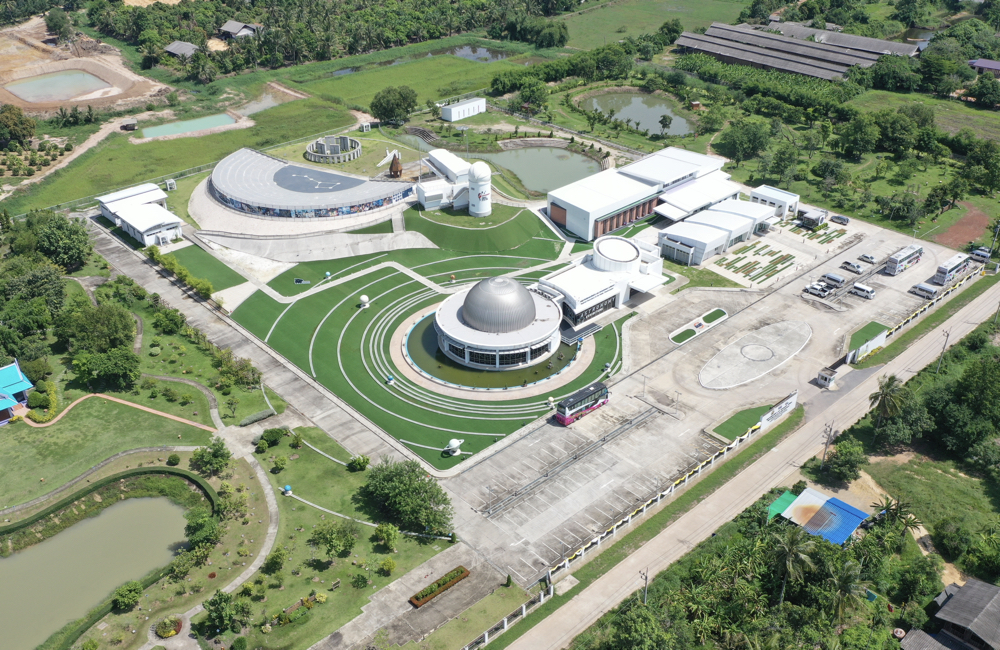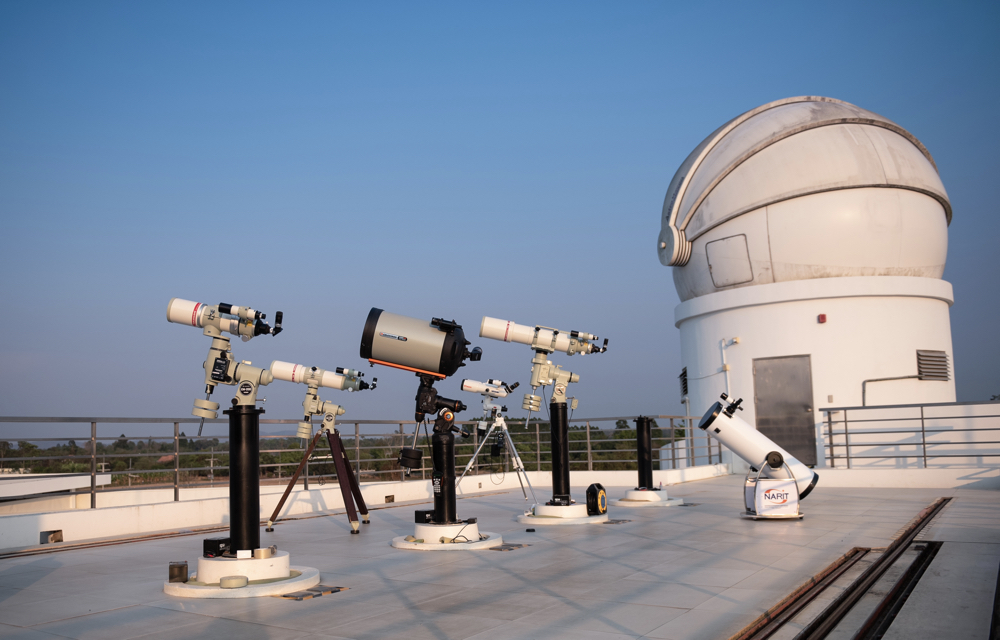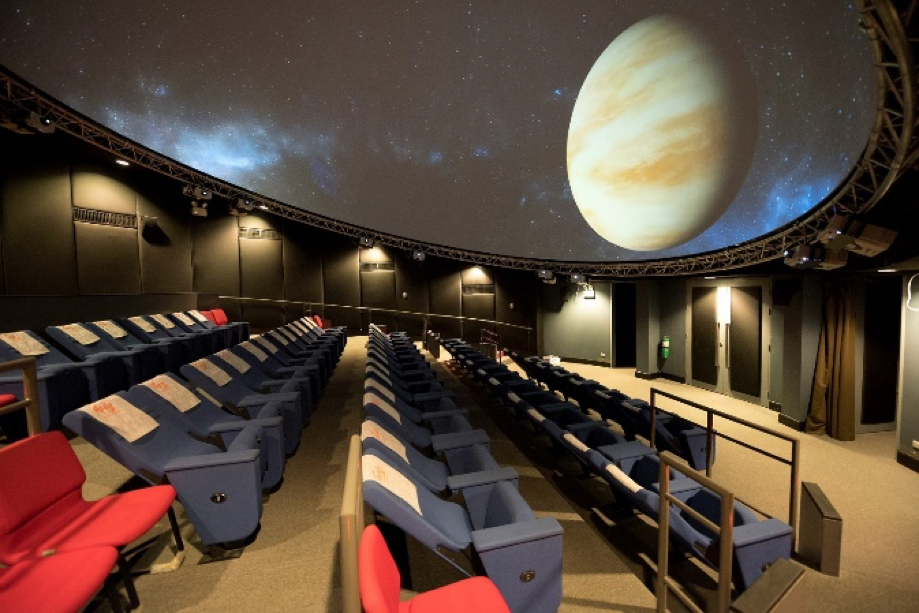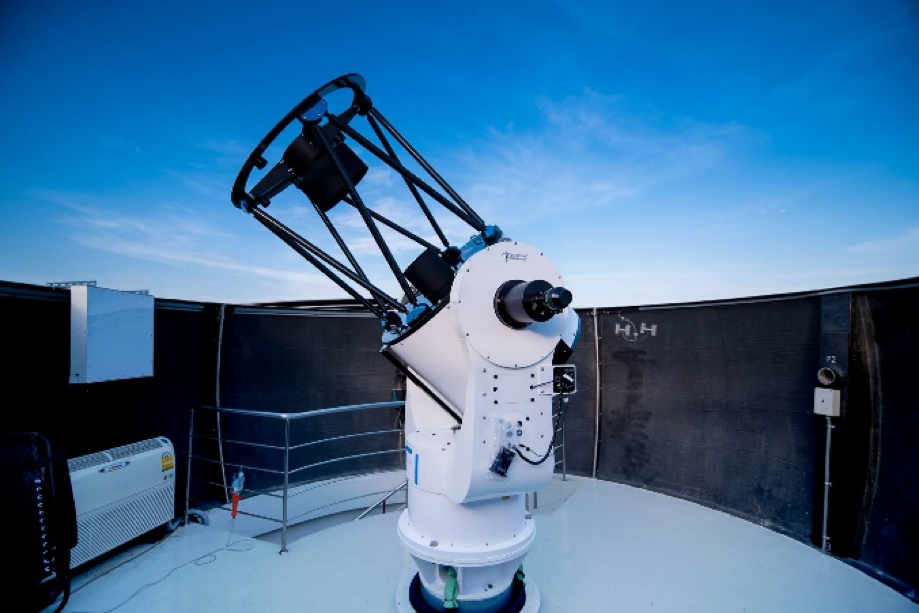
Regional Observatory for the Public, Chachoengsao
Regional Observatory for the Public, Chachoengsao
National Astronomical Research Institute of Thailand (Public Organization)
Ministry of Higher Education, Science, Research and Innovation
‘Chalermprakhiat’ Astronomical Observatory Commemorating King Bhumibhol's 7th Cycle Birthday Anniversary, Chachoengsao or the Regional Observatory for the Public, Chachoengsao is the second astronomical learning centre that operates in full capacity, located at 999, Wang Yen, Pleang Yao District in Chachoengsao Province with 36 Rais of land, donated by the Wang Yen temple. It provides academic services in astronomy to local and nearby communities, as well as supports astronomy curricula in schools, fundamental research and is an astro-tourism attraction in the region.

Infrastructures within ROP, Chachoengsao
- Planetarium – comprised of the 10-metre projection dome, equipped with Fulldome Digital Projector with 25 million pixels, displaying the Stellarium program with sky objects such as stars, constellations, sun, moon, galaxies, nebulae, clusters and other planets appeared in the designated dates and times. Information on celestial spheres, celestial coordinates and short documentaries on solar system, deep sky objects and astronomical films are also available.
- Astronomical Exhibition Building – Displaying interactive learning exhibition, for visitors to have virtual experience. The exhibition comprises of 14 different zones namely;
- Spectrum and Astronomical Discovery
|
- Spectrum and Astronomical Discovery |
- Solar Observation |
|
- Light Concentration of telescopes |
- Planet Weights in the Solar System |
|
- Light Refraction |
- Light & Astronomical Photography |
|
- Colors of Light Combination |
- Meteors |
|
- Moon Phases |
- The Significance of Telescope Aperture |
|
- Gas Planet Self-orbit |
- Moon Exploration |
|
- Moon Craters |
- Seasons & Earth Orbit around the Sun |
- Observation Tower – Comprised of a shell-shaped fiberglass dome with 18-foot diameter that opens up to 180 degrees, enabling to observe the all sky. It is equipped with 0.7-metre optical telescope – mainly used for research purposes. It is operated and controlled by the CCD computer for data handling, equipped with a professional eyepiece to observe celestial objects. Other equipment for astronomical research use can also be connected such as spectrograph.
- Astronomical Learning Center – for hosting learning activities, events, lectures and exhibition
- Planet Walk – Designed under the concept ‘self-learning exploration’ around the compound, by transforming the familiar Solar System into different parts of the ROP.
The Planetarium acts as the Sun – center of the Solar System and surrounded by other planets, telling interesting facts about astronomy to visitors.
1.6 Stonehenge Replica – The circular complex used for sunrise/sunset observation. The horseshoe arrangements are aligned to the sunset of the winter solstice and the opposing sunrise of the summer solstice. This enables the pre-historic settlers to calculate a total of 365 days in a year and how seasons change. As for this replica, it is a 1/3 smaller in size of the actual Stonehenge, facing at 13.6°N latitude, where the ROP, Chachoengsao is located.
- Samrat Yantra Replica – Samrat Yantra is an astronomical observatory, equipped with a sundial instrument from Jantar Mantar Memorial where all astronomical architectures built by the Rajput king Sawai Jai Singh II are located. The site was completed in 1738 in Jaipur, Rajasthan, India.
The sundial consists of gnomon, laying its shadow onto the background plate, which casts a shadow onto the dial. As for this Samrat Yantra replica, the dial is made of a slope, coincides with an observer angle (13.6°N for ROP, Chachoengsao) pointing towards the north, aligned with the circular plate in the background according to the dial. Given the tilted dial at this latitude, making the slope goes in parallel with the Earth’s axis, the Sun shadow thus lays in circle surrounding the slope regardless of the sun coordinates on the sky.
The sundial can tell the local solar modern time, for example, the local solar modern time at 12.00 hour, the sun will appear right upon the Meridian line, making the Samrat Yantra appears at its shortest, without appearing on the background plate. However, the local time we refer to is Thailand standard time, which is a comparison to the local solar modern time at the approximate 105° Longitude (in Ubon Ratchathani Province). And does not take into account the Earth orbit that makes the solar time slightly different to the standard time of the year.
- Astronomical Painting Wall
- Observation Ground – for hosting observation events during astronomical phenomena with the capacity of 1,500 people.
- Camping Ground – an open space for visitors to camp out overnight while attending astronomy camp and during astronomical phenomenal observation
- Botanical Garden – With the generosity of Toyota Motors (Thailand) and the Eastern Water Resources Development and Management Public Company Limited, allowing the ROP, Chachoengsao to construct the botanical garden surrounding the observatory compound including edible and religious plants, along with the irrigation system under the support of Santhithamathorn Foundation. This garden stands as a natural learning landmark, along with science.

ROP, Chachoengsao Services
Academic services at ROP are aimed to raise awareness of astronomy education to the public, covering all levels from children, youth, teachers, general public and amateur astronomers. This will ultimately create inspiration and uplift the knowledge-based society in science and technology. Each activity held was carefully designed and customized according to each target such as;
- Astronomical knowledge transfer for students, undergraduates and general public
- Astronomy camps for students, undergraduates and educational institutions
- Astronomical research support for students, undergraduates and educational institutions
- Astronomical Teacher Trainings
- Celestial object observation events
Service hours
Activities and Services
Tuesday – Sunday
(Close on Monday)
Planetarium Entrance Fees (per person)
Adult: 50 Baht
Student: 30 Baht
Free entry for small children, elderly, monks and people with disabilities
Planetarium Screenings (FullDome Digital):
Tuesday – Friday: 11.00 – 12.00 and 15.00 – 16.00 hours
Sunday: 10.00 – 11.00 and 14.00 – 15.00 hours
NARIT Public Night
Observation through telescopes
Saturday: 18.00 – 22.00 hours
*** Free of Charge ***

Academic Contents
Within the ROP, there are various services provided on astronomical knowledge including;
Astronomy Exhibition – Displaying 14 interactive astronomical stations. The exhibition is designed and developed by NARIT’s homegrown officers, to allow visitors for self-learning and first-hand experience and experiment.
Planetarium – for celestial interpretation, stars, the rounded screen gives a concrete idea of an actual sky, making it understandable for all. The overwhelming excitement of the stars, Sun, Moon, galaxies, nebulae, clusters, planets and deep sky objects onto the screen never disappoint!
Apart from the lectures for visitors, ROP is also available for teachers and students to access the planetarium as their own classroom in the school curriculum.
Learning Process Management
Activities are focused to cover all 4 different targets namely;
- General public
- Children and Youth
- Teachers
- Amateur astronomers
This will ultimately create inspiration and uplift the knowledge-based society in science and technology. Each activity held was carefully designed and customized according to each target such as;
- Activities for the public such as observation on tour, NARIT Public Night every Saturday, Astronomical Phenomenal observation such as total lunar eclipse, annual super full moon, Jupiter opposition, Saturn opposition
Astronomy Family Camp – is one of many activities held exclusively for the public with high popularity. It is focused on family, a vital foundation for quality human capacity building. This is done through astronomical equipment, toolkits, and infrastructures.
- Activities for children and youth: ROP, Chachoengsao has been implementing various types of astronomical activities for children and youth such as Astronomy camps for youth, providing learning experience in astronomy with first-hand observation, telescope operation and other equipment. Astronomy rally, for students to start their own astronomy rally in schools, astronomy activities at schools, young astronomy communicator workshop, so that students can communicates their knowledge to their own domains, and become volunteers at ROP in assisting visitors. ROP, Chachoengsao also provides special activities for children with disabilities, by bringing students from Panyanukul school from Bangkok and Chachoengsao together through the customized activities of their needs.
- Activities for teachers: ROP, Chachoengsao realizes the importance of knowledge transfer for teachers and educators as they are the core center to disseminate these knowledge onto the students. This is done from the very fundamental basic knowledge in astronomy, strengthening learning management skills, toolkit development and ultimately transfer these skills onto the students in the long run.
- Activities for amateur astronomers: enabling those with keen interests in astronomy to have access to ROP infrastructures, with the platform to exchange experience between astronomers, and enhancing networks for amateur astronomers.
At the present days, Thai society is transforming into the aging society with emerging elderly. In the future, the ROP, Chachoengsao will come up with customized activities to serve the elderly.
Types of Telescopes for observation services
- 14-meter Telescope is an up-to-date telescope, equipped with navigation and automatic tracking system for celestial objects, with Guider Scope to assist with high definition astrophotography.
Celestron EdgeHD 1400 , EdgeHD 9.25
Optical System : Advanced Coma-Free Telescope
Telescope Aperture : 14 inch (365 mm.) , 9.25 inch (234.95 mm)
Focal Length : 3910 mm. , 2350 mm.
Focal Ratio : F/11 , F/10
Mounting System : Equatorial Mount (CGE PRO , CGE)
- 150-milimeter High Quality Refracting Telescope, stands out with Apochromatic lens that comes in such a quality, making it visible to observe closely the Moon craters, Cloud details, Jupiter’s red storm and Mars craters.
Takahashi TOA-150
Optical System : Refractor - Apochromatic
Telescope Aperture : 6 inch (150 mm.)
Focal Length : 1100 mm.
Focal Ratio : F/7.33
Mounting System : Equatorial Mount (EM-400)
- 130-milimeter High Quality Refracting Telecsope, stands out with Apochromatic lens that comes in such a quality. It is available for the public, who may bring along their cameras to connect with the telescope for their own astrophotography every Saturday night.
Takahashi TOA-130
Optical System : Refractor - Apochromatic
Telescope Aperture : 5.11 inch (130 mm.)
Focal Length : 1000 mm.
Focal Ratio : F/7.7
Mounting System : Equatorial Mount (EM-200)
- 106-milimeter Refracting Telescope, for large celestial object observation such as Moon, Orion Nebula, Pleiades.
Takahashi FSQ-106
Optical System : Refractor - Apochromatic
Telescope Aperture : 4.2 inch (106 mm.)
Focal Length : 530 mm.
Focal Ratio : F/5
Mounting System : Equatorial Mount (EM-200)
- 125-milimeter Binoculars is a large binoculars used for planet observation, open cluster, moon. This type of binoculars provide a rather dimentional images to observers than other types of telescopes.
Vixen BT126ss-A
Optical System : Refractor - Apochromatic
Telescope Aperture : 4.9 inch (126 mm.)
Focal Length : 625 mm.
Focal Ratio : F/5
Mounting System : Equatorial Mount (Sirius) (astrotech)
- Solar Telescope, designed especially for safe solar observation. Observers are able to see clearly of Solar Prominence, while other telescopes with solar filter could only see the sun spots.
Coronado 90 mm.
Optical System : Refractor - Apochromatic
Telescope Aperture : 3.5 inch (90 mm.)
Focal Length : 792 mm.
Focal Ratio : F/8.8
Filter : Hydrogen - Alpha
Mounting System : Equatorial Mount (Sirius,astrotech)
Types of Telescopes for astronomical education
- 10-inch Dobsonian Telescope is the fundamental telescope used for youth activities at ROP, Chachoengsao.
- Large Refracting Telescope, 4-inch and 5-inch telescopes are used for trainings and workshops at ROP, Chachoengsao
- Telescope Assemble Set, used for refracting telescope assemble process.
Contact Us
Regional Observatory for the Public, Chachoengsao
999 Wang Yen, Plaeng Yao District, Chachoengsao Provicne 24190
Tel. 038-589-395, 084-088-2264
Fax. 038-589-396
Facebook: @NARITCCO
Divisions:
Academic Services: Tel. 053-121268-9 ext. 632
Public Relations: Tel. 053-121268-9 ext. 635
Finance and Budget: Tel. 053-121268-9 ext. 633